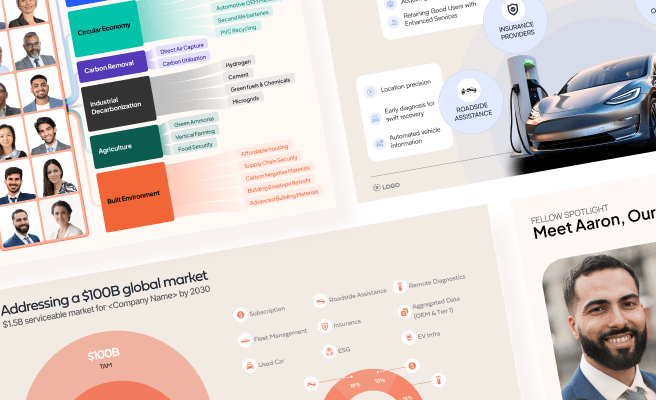Business Canvas
<p>A business canvas is a strategic management tool that allows companies to develop and visualize their business model. It is particularly essential for startups and organizations in the climate tech sector, where innovation and sustainable practices are key. By mapping out different components of a business model, a business canvas helps teams align their strategies, identify potential challenges, and create value for customers.</p>
<p>Originally introduced by Alexander Osterwalder in his book "Business Model Generation," the business canvas consists of nine fundamental building blocks: Customer Segments, Value Propositions, Channels, Customer Relationships, Revenue Streams, Key Resources, Key Activities, Key Partnerships, and Cost Structure. Each block represents a critical aspect of the business, enabling a comprehensive view of how the company intends to create, deliver, and capture value.</p>
<h2 id="2">Components of a Business Canvas</h2>
<p>The nine building blocks of a business canvas are interconnected and provide a holistic view of the business model:</p>
<h3 id="3">1. Customer Segments</h3>
<p>Identifying the groups of people or organizations a business aims to reach and serve. For example, a climate tech startup might target agricultural companies looking to reduce their carbon footprint.</p>
<h3 id="4">2. Value Propositions</h3>
<p>Describes the unique value a company offers to its customers. In the climate tech sector, this could be innovative technology that enhances sustainability, such as a carbon capture solution.</p>
<h3 id="5">3. Channels</h3>
<p>The various means through which a company delivers its value proposition to its customers. It includes communication, distribution, and sales channels.</p>
<h3 id="6">4. Customer Relationships</h3>
<p>Types of relationships a company establishes with its customer segments. This could range from personalized service to automated support.</p>
<h3 id="7">5. Revenue Streams</h3>
<p>The different ways a company generates income. For instance, a company in the climate tech industry might have revenue streams from product sales, subscriptions, and consulting services.</p>
<h3 id="8">6. Key Resources</h3>
<p>Critical assets required to deliver the value proposition. These can be physical, intellectual, human, or financial resources.</p>
<h3 id="9">7. Key Activities</h3>
<p>Important actions a company must take to operate successfully. For a climate tech company, key activities could include research and development, marketing, and customer support.</p>
<h3 id="10">8. Key Partnerships</h3>
<p>Network of suppliers and partners that help the business model work. Partnerships can enhance capabilities and reduce risk, such as teaming up with research institutions for technological advancements.</p>
<h3 id="11">9. Cost Structure</h3>
<p>Describes all costs incurred to operate a business model. This includes fixed and variable costs, and for climate tech companies, it might involve R&D expenses and operational costs.</p>
<h2 id="12">Practical Applications of Business Canvas</h2>
<p>A business canvas is not just a theoretical tool; it offers practical applications that can drive real-world success. Here are a few ways it can be utilized:</p>
<p><strong>Strategic Planning</strong>: Companies can use the business canvas during strategic planning sessions to align their team on the business model and identify areas for improvement.</p>
<p><strong>Pitch Decks</strong>: Startups can incorporate the business canvas into their pitch decks to clearly communicate their business model to investors. <a href="https://www.strategyzer.com/canvas/business-model-canvas" style="color: #2896FF; text-decoration: underline;">Strategyzer</a> offers templates specifically for this purpose.</p>
<p><strong>Workshops</strong>: Conducting workshops with stakeholders using the business canvas can foster collaboration and generate innovative ideas. <a href="https://hbr.org/2013/05/why-the-lean-start-up-changes-everything" style="color: #2896FF; text-decoration: underline;">Harvard Business Review</a> discusses the effectiveness of such workshops in the lean startup methodology.</p>
<h2 id="13">Real-World Examples</h2>
<p><strong>Tesla</strong>: Tesla uses a business canvas to continuously innovate and refine their business model. Their focus on customer segments interested in sustainable transportation and their unique value proposition of high-performance electric vehicles have been pivotal in their success. <a href="https://www.forbes.com/sites/garydrenik/2021/02/16/what-teslas-business-model-can-teach-us-about-innovation/?sh=1bfa4b5b6a5b" style="color: #2896FF; text-decoration: underline;">Forbes</a> provides an in-depth analysis of Tesla's business model.</p>
<p><strong>Patagonia</strong>: Known for its commitment to sustainability, Patagonia leverages the business canvas to align its operations with environmental values. The company's value proposition includes high-quality, eco-friendly products, and they maintain strong customer relationships through transparent practices and activism. Read more on their approach on <a href="https://www.patagonia.com/sustainability/" style="color: #2896FF; text-decoration: underline;">Patagonia's sustainability page</a>.</p>
<h2 id="14">Conclusion</h2>
<p>In summary, a business canvas is an invaluable tool for developing and visualizing a business model. It’s especially useful in the climate tech sector, where innovation and sustainability are crucial. By understanding and utilizing the nine building blocks, companies can create a cohesive strategy that aligns with their goals and drives success.</p>
</p> <p>Increase user engagement that converts your demos into sales. Optimise your UX strategies with our audits.
<p>Fill out the <a href="https://tally.so/r/n97pxQ" style="color:#2896FF; text-decoration:underline;">UX Audit form</a> to get started. Ready to discuss your needs? <a href="https://cal.com/akhilak/what-if-design?duration=25" style="color:#2896FF; text-decoration:underline;">Book a consultation call</a> with us today.</p></p>

Let's scale your impact with great design.
Free consultation, no sales pitch
Thank you! Your submission has been received!
Oops! Something went wrong while submitting the form.
Let’s talk
Nothing great is built alone.
Let’s connect about your vision, our work and how we can collaborate.
Get in touch

